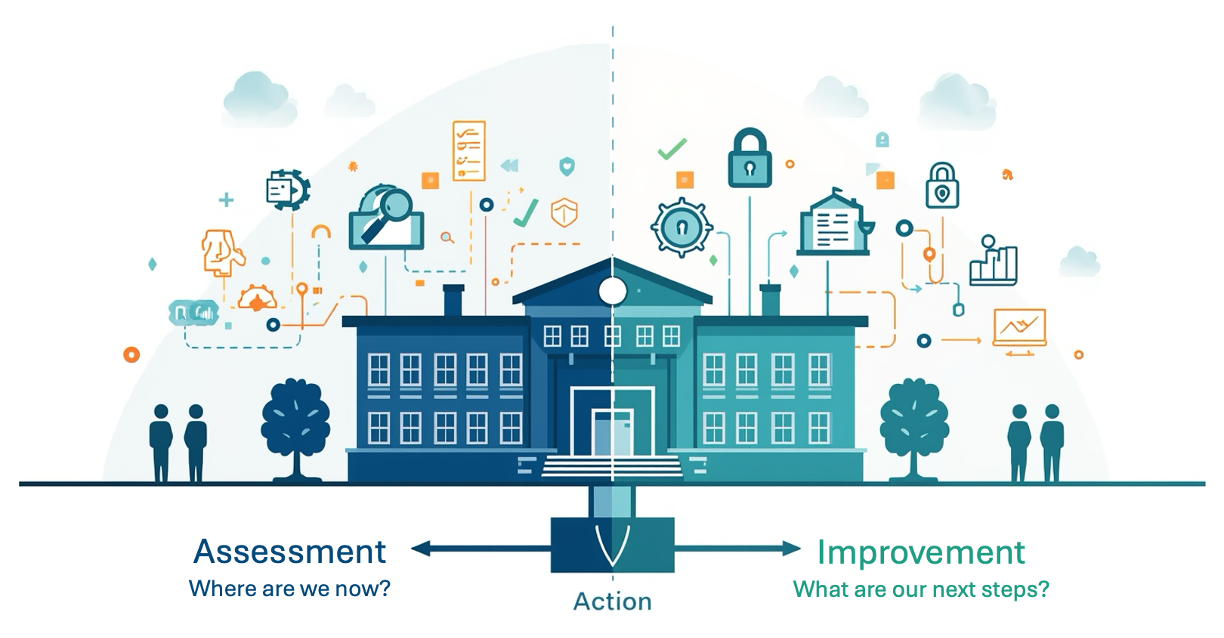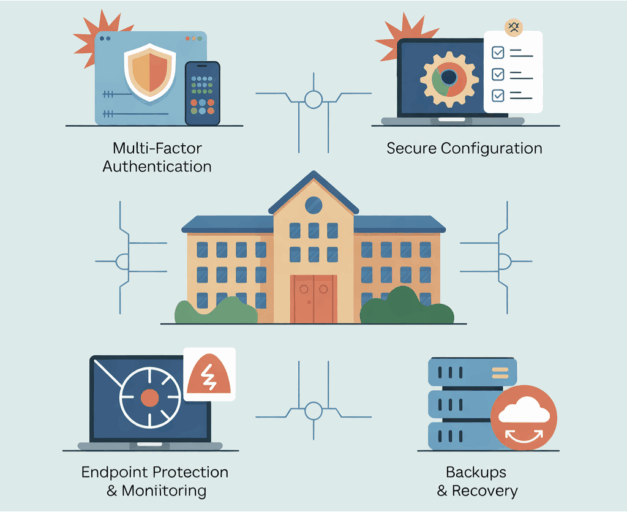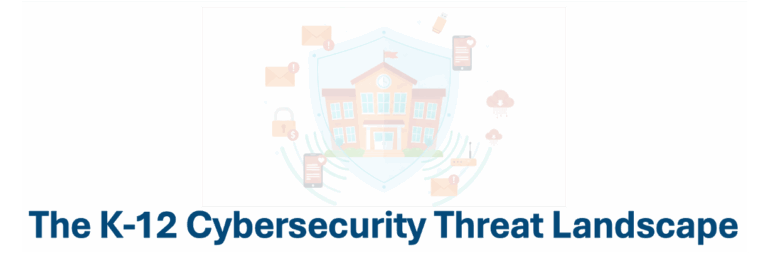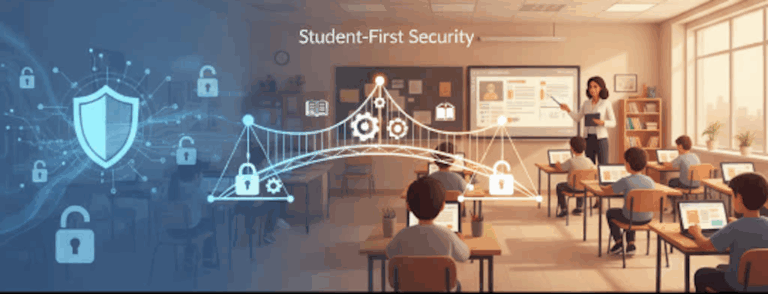From Assessment to Action: A Practical Guide to K-12 Cybersecurity
Last month, a mid-sized district in Texas completed a cybersecurity assessment. When they were finished the question remained. “Now what?” Their IT director knew what the gaps were, but the question that kept him up at night wasn’t “what’s wrong?” — it was “what do we actually do about it with the resources we have?”
This situation isn’t unique. If you’ve gone through any degree of assessment, you’ve probably had the same moment. You have a snapshot of your current state but then what? How do you compare to other schools or districts? And what should your next steps be. The scoring reveals your gaps. But then what? How do you make any improvements when you have two IT staff, a shrinking budget, and a superintendent who needs to see results before their next school board meeting?
That’s what we’re addressing with this series.
The Problem with Most Cybersecurity Guidance
Here’s what typically happens: A district completes their assessment, identifies areas needing improvement, and then searches for solutions. What they find are enterprise security frameworks written for corporations with dedicated security teams, unlimited budgets, and Chief Information Security Officers who speak a language most K-12 leaders don’t understand.
The disconnect is real. Your assessment might show that you need help with identity management, but enterprise guidance assumes you have Active Directory experts on staff. It might identify gaps in incident response, but the implementation guides assume you have a 24/7 Security Operations Center.
K-12 doesn’t work that way. You have one person handling help desk tickets, network management, device deployment, and cybersecurity. You have summer implementations compressed into weeks because buildings close. You have substitute teachers who need access immediately because learning can’t wait. You have students testing your network boundaries every single day.
Assessment + Implementation = Progress
We’ve spent the last year developing the K-12 Cybersecurity Framework to address exactly these challenges. It’s designed to work alongside assessment tools like the Cybersecurity Rubric, creating a sustainable improvement cycle:
ASSESS → Where are we now?
IMPLEMENT → How do we improve?
MEASURE → Did it work?
Over the coming weeks, we’ll be breaking down each chapter of the framework and connecting it directly to common assessment domains. Each post will answer three questions:
- What does your assessment tell you about this area?
- What does the framework recommend you actually do?
- How do you know it’s working?
What Makes This Different
This isn’t theory. The framework is built from real district experiences — from the CTO who figured out how to segment networks without disrupting summer school, to the technology director who built a phishing training program that actually changed staff behavior, to the small district that cut cyber insurance costs by 40% through strategic improvements.
Every chapter includes:
- Voices from the Field — real quotes from practitioners facing your same challenges
- What Your Boss Should Know — executive talking points that translate technical work into business outcomes
- Practical implementation steps — not “implement zero trust,” but “here’s how to start network segmentation with your current infrastructure”
The framework respects your reality. It assumes tight budgets, small teams, and competing priorities. It provides phased approaches so you can start this week, not next year. And it connects directly to common assessment domains so you can measure progress.
What’s Coming
In the weeks ahead, we’ll explore:
Student-First Security — How to balance protection with learning
Threat Landscape — Understanding what districts actually face
Essential Cyber Hygiene — The foundation that makes everything else work
Default to Isolation — Network segmentation strategies for K-12
Identity Management — The beating heart of K-12 security
Phased Implementation — How to progress from basic to advanced practices
Resource-Constrained Solutions — What to do when you have more gaps than budget
And more. Each post will connect directly to common assessment areas and show you how to turn assessment results into actionable improvements.
Starting the Journey
If you’ve completed any cybersecurity assessment and wondered “now what?” — this series is for you.
If you haven’t done an assessment yet, we recommend starting with the Cybersecurity Rubric. It’s free, it’s designed for K-12, and it gives you the baseline you need. Then use this series to build your implementation roadmap.
If you’re somewhere in the middle — making progress but not sure what to tackle next — these posts will help you prioritize and sequence your work.
The goal isn’t perfection. The goal is measurable progress that protects students and learning while respecting your constraints.
Pasadena ISD used this assess-implement-measure cycle to cut cyber insurance by 40%. Mt. Vernon built a high school cybersecurity academy. Wayland Public Schools made data governance their bridge between IT and operations.
Your district’s story will be different, but the principles are the same: assess honestly, implement strategically, measure consistently.
The Complete Toolkit
Together, assessment tools like the Cybersecurity Rubric and the K-12 Cybersecurity Framework give you what most districts need:
Assessment tools measure where you are and identify gaps
The Framework shows you how to improve and provides implementation steps
Your Team makes it real in your unique context
Over the coming weeks, we’ll show you how to use both tools to build cybersecurity that actually works in K-12 environments — not enterprise theory, but practical guidance for real districts with real constraints.
The next post starts with Student-First Security — why K-12 cybersecurity is fundamentally different and how to balance protection with learning. We’ll connect it to common assessment areas and show you exactly where to start.
Because cybersecurity in K-12 isn’t about perfect security. It’s about sustainable, effective security that protects learning.
The K-12 Cybersecurity Framework and Cybersecurity Rubric are both free resources designed specifically for K-12 districts. Learn more at [K12Leaders.com/cybersecurity] and [link to Cybersecurity Rubric].
🔗 Related Resources
This framework is a field‑tested guide created with district technology leaders, cybersecurity practitioners, and K‑12 realities in mind. It aligns with widely used standards while staying focused on what school teams can actually implement with limited staff and budgets. It is vendor‑neutral, practical, and designed to help leaders establish cybersecurity priorities to keep their learning environments secure.
Created by a coalition of partners and K-12 technology leaders, the Cybersecurity Rubric helps schools assess where they are on their path to ensuring a more secure learning environment.
NetAlly empowers education system IT leaders and technologists to protect students, staff, and data while keeping classrooms connected and learning uninterrupted. Because when the network works, the lesson plan works.







